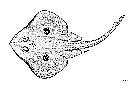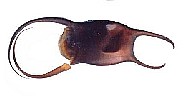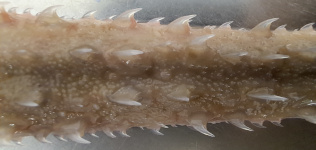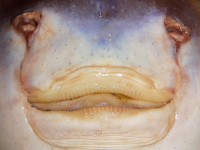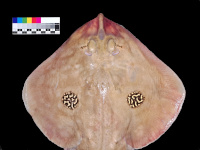Leucoraja naevus
(Müller & Henle, 1841)
Cuckoo ray
Classification: Elasmobranchii Rajiformes Rajidae
Reference of the original description
Systematische Beschreibung der Plagiostomen. Berlin, Veit, pp. 1–200
Systematische Beschreibung der Plagiostomen. Berlin, Veit, pp. 1–200
Image of the original description
No image in first description.
No image in first description.
Synonyms / new combinations and misspellings
Amblyraja naevus, Raia naevus, Raja naevus, Raja (Leucoraja) naevus
Amblyraja naevus, Raia naevus, Raja naevus, Raja (Leucoraja) naevus
Description :
Citation: Leucoraja naevus (Müller & Henle, 1841): In: Database of modern sharks, rays and chimaeras, www.shark-references.com, World Wide Web electronic publication, Version 01/2026
Please send your images of "Leucoraja naevus" to info@shark-references.com
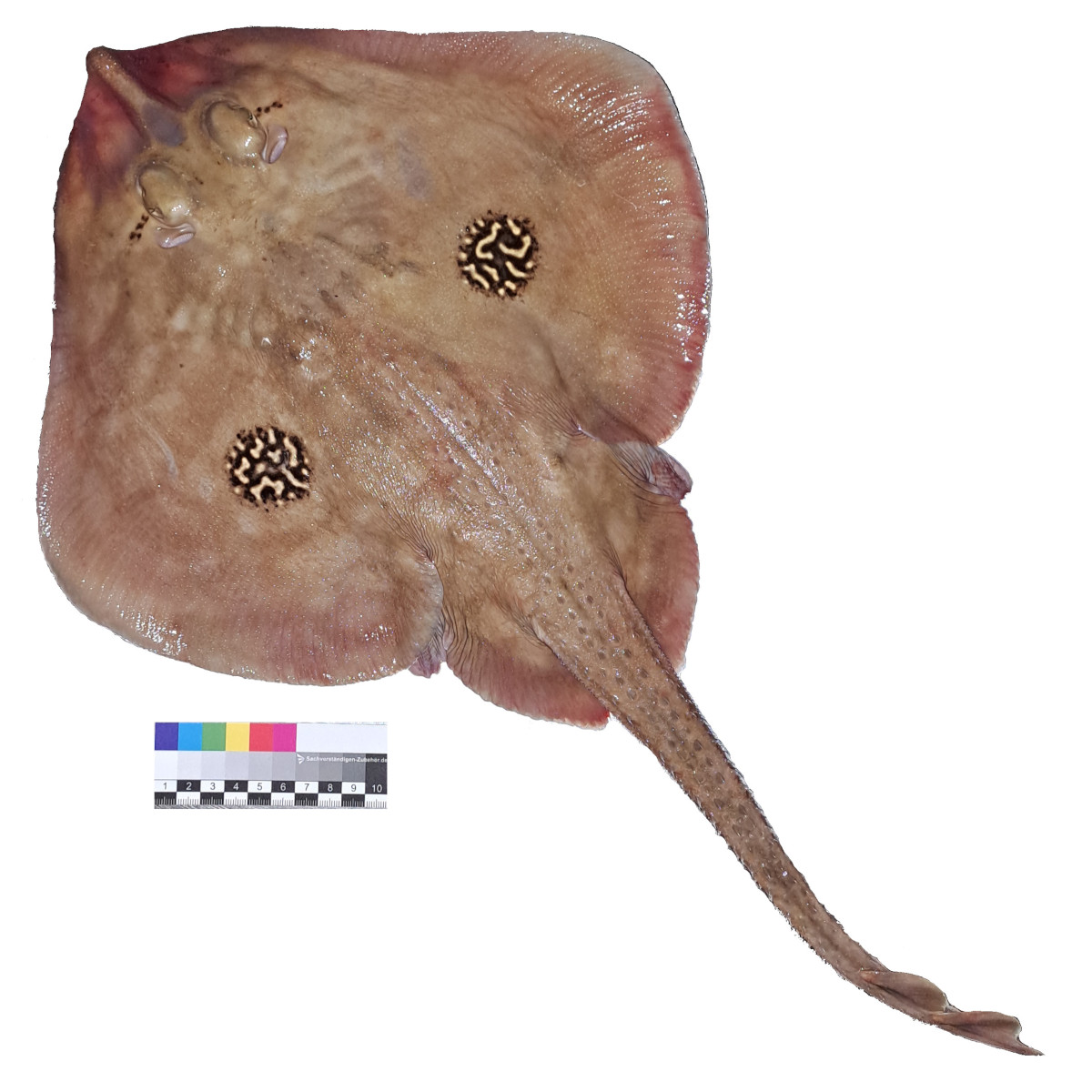
Leucoraja naevus (Müller & Henle, 1841), 23.01.2025, Port of Castelló, western Mediterranean, Spain © Jaime Penadés-Suay, Associació LAMNA

Leucoraja naevus (Müller & Henle, 1841), 23.01.2025, Port of Castelló, western Mediterranean, Spain © Jaime Penadés-Suay, Associació LAMNA
Common names
 Kuckucksrochen,
Kuckucksrochen,  Raia santiaguesa,
Raia santiaguesa,  Raya de San Pedro,
Raya de San Pedro,  Raya santiaguesa,
Raya santiaguesa,  Raya santiguesa,
Raya santiguesa,  Raie fleurie,
Raie fleurie,  Butterfly skate,
Butterfly skate,  Cuckoo ray,
Cuckoo ray,  Cuckoo skate,
Cuckoo skate,  Sandy ray,
Sandy ray,  Pichira rutunnula,
Pichira rutunnula,  Razza cuculo,
Razza cuculo,  Razza fiorita,
Razza fiorita,  Raia-de-dois-olhos
Raia-de-dois-olhos
 Kuckucksrochen,
Kuckucksrochen,  Raia santiaguesa,
Raia santiaguesa,  Raya de San Pedro,
Raya de San Pedro,  Raya santiaguesa,
Raya santiaguesa,  Raya santiguesa,
Raya santiguesa,  Raie fleurie,
Raie fleurie,  Butterfly skate,
Butterfly skate,  Cuckoo ray,
Cuckoo ray,  Cuckoo skate,
Cuckoo skate,  Sandy ray,
Sandy ray,  Pichira rutunnula,
Pichira rutunnula,  Razza cuculo,
Razza cuculo,  Razza fiorita,
Razza fiorita,  Raia-de-dois-olhos
Raia-de-dois-olhos
Short Description
Snout short; upper surface entirely spinulose, but centre of pectoral fins more or less bare in adults, underside smooth except for prickly front edges; generally 9-13 thorns in a complete row around inner margin of eye, and a large triangle of thorns on nape or shoulder region; two parallel rows of strong thorns on each side of midline along tail; upper surface ochre to light greyish-brown with a large roundish black eye-spot in middle of each pectoral fin, underside white [7182]
Snout short; upper surface entirely spinulose, but centre of pectoral fins more or less bare in adults, underside smooth except for prickly front edges; generally 9-13 thorns in a complete row around inner margin of eye, and a large triangle of thorns on nape or shoulder region; two parallel rows of strong thorns on each side of midline along tail; upper surface ochre to light greyish-brown with a large roundish black eye-spot in middle of each pectoral fin, underside white [7182]
Distribution
Eastern Atlantic: Kattegat [7182] and North Sea, around Great Britain, Ireland and the Mediterranean to Morocco and Senegal. Source: www.gbif.org
Eastern Atlantic: Kattegat [7182] and North Sea, around Great Britain, Ireland and the Mediterranean to Morocco and Senegal. Source: www.gbif.org
Human uses
fisheries: commercial; aquarium: public aquariums
fisheries: commercial; aquarium: public aquariums
Biology
Oviparous, paired eggs are laid. Embryos feed solely on yolk [733]. Distinct pairing with embrace. Young may tend to follow large objects, such as their mother [17086]. Reproductive biology: Portuguese continental waters (data base: 856 specimens, 501 females, 355 males): No difference in size at maturity was detected between sexes, which was estimated as 56 cm total length. Spawning occurs all year round, but maximum activity was during winter months. Maximum fecundity is c. 63 eggs female−1 year−1. Encapsulated eggs are released in batches, nine in total with a mean number of seven extruded eggs in each batch [17307];
Oviparous, paired eggs are laid. Embryos feed solely on yolk [733]. Distinct pairing with embrace. Young may tend to follow large objects, such as their mother [17086]. Reproductive biology: Portuguese continental waters (data base: 856 specimens, 501 females, 355 males): No difference in size at maturity was detected between sexes, which was estimated as 56 cm total length. Spawning occurs all year round, but maximum activity was during winter months. Maximum fecundity is c. 63 eggs female−1 year−1. Encapsulated eggs are released in batches, nine in total with a mean number of seven extruded eggs in each batch [17307];
Remarks
shark-references Species-ID=3495;
shark-references Species-ID=3495;
Parasites (arranged by Jürgen Pollerspöck)
Monogenea
Cestoda
Nematoda
Copepoda
- Taeniacanthus sp. [16598]
Monogenea
- Acanthocotyle lobianchi Monticelli, 1888 [15273] [15267]
- Calicotyle kroyeri Diesing, 1850 [17150] [15273] [15268] [7377]
- Dictyocotyle coeliaca Nybelin, 1941 [15076] [23943] [15251] [15273]
- Empruthotrema raiae (Maccallum, 1916) Johnston & Tiegs, 1922 [15273] [17002]
- Rajonchocotyle emarginata (Olsson, 1876) [15273] [15243] [17450] [33185]
- Rajonchocotyle miraletus Rees & Llewellyn, 1941 [17150]
Cestoda
- Acanthobothrium quadripartitum Williams, 1968 [16954] [16448] [16957] [23995] [16910] [15084] [28741]
- Echeneibothrium sp. [15084] [33185]
- Echinobothrium harfordi Mcvicar, 1976 [15084] [16430] [19536]
- Echinobothrium sp. [17100] [16910]
- Grillotia erinaceus (Van Beneden, 1858) [16112] [15084] [7411] [33185]
- Rockacestus piriei (Williams, 1968) [16956] [16910] [15084]
Nematoda
- Anisakis simplex (Rudolphi, 1809) [33185]
- Capillaria sp. [17100]
- Pancreatonema torriense McVicar & Gibson, 1975 [23993]
- Phocanema sp. [33185]
Copepoda
- Caligus curtus Müller, 1785 [16598]
- Caligus elongatus Von Nordmann, 1832 [16598]
- Eudactylina similis Scott, 1902 [16598]
- Lernaeopodina longimana (Olsson, 1869) [16598]








